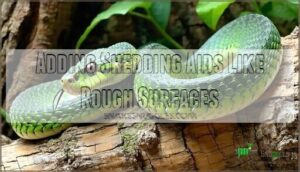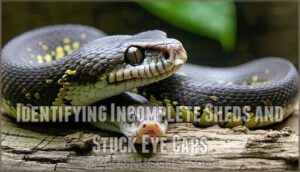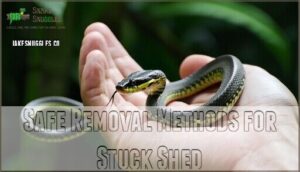This site is supported by our readers. We may earn a commission, at no cost to you, if you purchase through links.

Don’t handle your snake during this 5-7 day process—it’s like interrupting someone changing clothes. After shedding, check for stuck pieces around the eyes and tail, then clean the enclosure thoroughly.
The key is patience and proper preparation. However, knowing when normal shedding goes sideways can save your snake‘s health.
Table Of Contents
- Key Takeaways
- Why Do Snakes Shed Their Skin?
- Preparing The Enclosure for Shedding
- Caring for Your Snake During Shedding
- How to Deal With Shedding Problems
- Post-Shedding Care and Health Monitoring
- Frequently Asked Questions (FAQs)
- How long does it take for a snake to shed its skin?
- Can I help my snake remove its shed skin?
- What should I do if my snake has difficulty shedding?
- What are some common causes of incomplete shedding in snakes?
- Can snakes eat during shedding periods?
- How often should water be changed while shedding?
- What temperatures are best during snake shedding?
- Do baby snakes need different shedding care?
- Should lighting be adjusted during shedding time?
- Conclusion
Key Takeaways
- You’ll need to boost humidity to 70-85% and provide rough surfaces like cork bark for your snake to rub against during the 5-7 day shedding process.
- Don’t handle your snake while it’s shedding – it’s stressed and has reduced vision, so minimize interaction and observe from a distance instead.
- After shedding, inspect your snake carefully for stuck pieces around the eyes and tail, then clean the enclosure thoroughly to prevent bacterial growth.
- Watch for warning signs of incomplete shedding like retained eye caps or patchy skin removal – these problems need immediate attention to prevent serious health issues.
Why Do Snakes Shed Their Skin?
Your snake sheds its skin through a natural process called ecdysis, which allows for growth and replaces old skin cells with fresh ones.
This biological renewal happens regularly throughout your snake’s life, with younger snakes shedding every few weeks while adults shed less frequently based on their growth rate and environmental conditions.
The Shedding Process Explained
Ecdysis, the snake shedding process, involves complete skin replacement through distinct stages. Your snake’s body produces lymph fluid between old and new skin layers, creating the characteristic cloudy-eyed appearance.
Here’s how the shedding process works:
- Pre-shed stage: Eyes turn milky blue as lymph fluid accumulates between skin layers
- Clear phase: Eyes clear temporarily before actual shedding begins
- Active shedding: Snake rubs against rough surfaces to start peeling
- Complete shed: Entire skin comes off in one piece, inside-out
- Recovery: Fresh, vibrant skin emerges with restored clarity
The shedding process duration usually spans 5-7 days from initial signs to complete shed. Snakes often shed to remove external parasites.
Factors Affecting Shedding Frequency
Several factors determine how often your snake sheds. Age plays the biggest role – young snakes shed every few weeks while adults shed monthly or less. Species variation matters too; some breeds naturally shed more frequently.
Environmental conditions like proper humidity and temperature directly affect shedding frequency. Your snake’s diet impacts cellular renewal, while health conditions can disrupt normal shedding cycles.
Signs Your Snake is About to Shed
Looking for signs your snake is about to shed? Watch for cloudy eyes (called spectacles), skin dullness, and behavior changes like appetite loss or hiding more.
These shedding signs usually appear 5-7 days before ecdysis begins. Your shedding snake becomes less active and may refuse food—completely normal responses to reduced vision and stress.
Preparing The Enclosure for Shedding
You’ll need to create the right environment before your snake starts shedding, much like preparing a spa day for your scaly friend.
Create the perfect shedding environment before your snake needs it most
Set up proper humidity levels, provide a humid hide with damp substrate, and add rough surfaces that help your snake remove its old skin naturally.
Increasing Humidity Safely
Proper humidity monitoring prevents shedding problems while maintaining your snake’s health. You’ll need to increase humidity to 70-85% during shedding using safe methods like misting systems or larger water bowls.
To achieve this, consider using absorbent bedding to help maintain humidity. Target your species’ specific needs and guarantee adequate enclosure ventilation to prevent mold.
A humid hide provides localized moisture without creating a swampy shedding environment.
Providing a Humid Hide and Proper Substrate
Beyond adjusting overall humidity, you’ll need a dedicated humid hide for your shedding snake. Place damp sphagnum moss or paper towels inside a hide box, maintaining substrate moisture levels around 80-90%.
Choose safe substrate types like cypress mulch or paper towels that won’t harbor mold. Position the humid hide on the warm side of the enclosure for ideal shedding environment effectiveness.
For ideal shedding, coconut husk fiber is a recommended choice.
Adding Shedding Aids Like Rough Surfaces
Rough surfaces become your shedding snake’s best friend during ecdysis. Place coarse materials like cork bark, natural branches, or textured rocks strategically around the enclosure. These abrasive surfaces help your snake initiate shedding by providing friction points.
You can even purchase specialized shedding products for this purpose. Combine rough textures with increased humidity for ideal results, preventing shedding problems naturally.
Caring for Your Snake During Shedding
Once you’ve prepared your snake’s enclosure, you’ll need to adjust your care routine during the actual shedding process. Your snake will be more stressed and vulnerable during this time, so you’ll want to minimize handling and watch for any complications that might require your attention.
Handling Restrictions and Stress Reduction
Most shedding snakes need space and quiet. Avoiding handling during this vulnerable period prevents stress and potential shedding problems.
Your shedding snake experiences reduced vision, making gentle handling essential if absolutely necessary. Reduce stressors by maintaining minimal interaction and dimming lights. Simply observe behavior from a distance.
The shedding process runs smoother when you resist the urge to help unnecessarily.
Monitoring The Shedding Process
During the snake shedding process, you’ll want to keep a watchful eye on your pet’s progress. Monitor these key indicators:
- Shedding Timeline – Most snakes complete ecdysis within 5-7 days from initial signs
- Behavior Changes – Expect reduced activity and appetite during this period
- Skin Appearance – Watch for the characteristic cloudy, bluish eye caps
- Hydration Levels – Make sure fresh water remains available throughout the process
Maintaining proper humidity helps prevent incomplete shedding issues.
Recognizing Normal Vs. Abnormal Shedding
Normal shedding produces a complete, intact skin in one piece. Your snake should shed within 7-10 days after initial signs appear.
Watch for behavioral changes like increased hiding or reduced appetite—these are typical. Abnormal shedding, called dysecdysis, shows as patchy skin removal or retained eye caps.
Frequency variations between species are normal, but sudden changes warrant attention. Quality matters more than speed.
How to Deal With Shedding Problems
Even with proper preparation, you’ll occasionally encounter shedding complications like stuck shed or retained eye caps that require immediate attention.
Recognizing these issues early and knowing safe removal techniques can prevent serious health problems and guarantee your snake completes the shedding process successfully.
Identifying Incomplete Sheds and Stuck Eye Caps
Spotting incomplete shedding requires careful observation after your snake’s ecdysis cycle completes. Look for these warning signs that indicate dysecdysis or retained skin patches requiring attention.
- Retained Skin Patches – Check for silvery, papery remnants clinging to body segments, especially around tail tips and between scales
- Eye Cap Issues – Examine spectacles for cloudy, dull appearance or visible old caps layered over new ones
- Recognizing Dysecdysis – Note patchy areas where skin appears doubled or wrinkled rather than smooth and uniform
- Shedding Problem Causes – Assess humidity levels, rough surfaces, and overall enclosure conditions that may contribute to incomplete sheds
- Veterinary Intervention Signs – Watch for multiple failed sheds, swollen areas, or behavioral changes indicating stuck shed complications
Safe Removal Methods for Stuck Shed
When stuck shed won’t budge naturally, gentle extraction methods can save the day. Start with lukewarm humidity soaks for 15-20 minutes, then use a damp cloth along scale direction.
For stubborn patches, try the pillowcase method or create a temporary sauna with damp substrate. A more effective method involves creating a snake sauna to raise humidity.
Never force removal—if it resists, stop immediately to prevent injury.
When to Seek Veterinary Care
Some shedding problems need professional veterinary care immediately. Watch for infection signs like open wounds, discharge, or foul odors around stuck shed areas.
Breathing issues, appetite loss, or lethargy signal serious health problems requiring urgent veterinary visits. Don’t wait when multiple symptoms appear together—your snake’s life depends on quick action.
Post-Shedding Care and Health Monitoring
Once your snake completes its shed, you’ll need to perform a thorough health check and clean the enclosure. This critical post-shed inspection ensures your snake’s well-being and prevents complications from retained skin or eye caps.
Checking for Retained Skin or Eye Caps
After your snake finishes shedding, you’ll need to play detective and inspect for any lingering problems. Check carefully for retained shed signs around the tail, toes, and especially the eyes.
- Eyes: Look for cloudy or dull spectacles that should appear clear post-shed
- Body: Examine for patchy areas where old skin remains stuck
- Extremities: Check tail tips and between scales for stubborn pieces
Eye cap issues require immediate attention since retained spectacles can cause serious vision problems. If you spot stuck shed, don’t panic—gentle removal with safe tools prevents future complications.
Cleaning The Enclosure After Shedding
After shedding completes, you’ll need to tackle enclosure cleanup promptly. Remove excess skin from the snake enclosure immediately to prevent bacterial growth and parasite prevention issues. Replace contaminated substrate and thoroughly sanitize the water bowl using appropriate sanitization methods. This maintenance ensures enclosure safety while controlling odor.
| Task | Method | Frequency |
|---|---|---|
| Shed disposal | Remove immediately with tongs | After each shed |
| Substrate change | Replace soiled areas completely | Weekly or as needed |
| Water bowl cleaning | Hot water and reptile-safe disinfectant | Every 3-4 days |
Monitoring Hydration and Overall Health
Once you’ve cleaned the enclosure, keep a watchful eye on your snake’s post-shed condition. Monitor these five key indicators:
- Hydration Assessment – Check for sunken eyes or wrinkled skin
- Behavior Changes – Note any lethargy or unusual activity patterns
- Respiratory Issues – Watch for mouth breathing or wheezing sounds
- Skin Condition – Inspect for retained shed or signs of dysecdysis
- Weight Monitoring – Track any significant changes in body mass
After shedding, inspect the skin to verify there are no retained eye caps. Contact your reptile veterinarian if shedding problems persist or worsen.
Frequently Asked Questions (FAQs)
How long does it take for a snake to shed its skin?
Ironically, while you’re anxiously watching your snake, the actual shedding process unfolds quite predictably. Complete ecdysis usually takes 5-7 days from the initial opaque phase to final skin removal.
Can I help my snake remove its shed skin?
You shouldn’t forcibly remove shed skin from your snake. Let them handle it naturally by providing proper humidity and rough surfaces for rubbing assistance instead.
What should I do if my snake has difficulty shedding?
Approximately 15% of pet snakes experience dysecdysis (stuck shed).
Increase humidity to 70-80%, provide a humid hide, and gently place your snake in a damp pillowcase for twenty minutes to soften stubborn skin.
What are some common causes of incomplete shedding in snakes?
Incomplete shedding usually stems from inadequate humidity levels, poor substrate choices, insufficient rough surfaces for rubbing, temperature fluctuations, dehydration, nutritional deficiencies, parasites, illness, or stress factors affecting your snake’s natural process.
Can snakes eat during shedding periods?
Like a snake hitting the snooze button, your pet usually won’t eat during shedding periods. Their vision becomes cloudy, making them less inclined to hunt or accept food until the process completes.
How often should water be changed while shedding?
Change your snake’s water daily during shedding. Fresh water promotes proper hydration and helps maintain the humidity levels needed for smooth skin removal. You’ll notice increased drinking after shedding completes.
What temperatures are best during snake shedding?
Maintain your snake’s normal temperature range during shedding. Don’t increase temperatures, as this can stress your pet and complicate the process.
Consistent basking and cool zones help guarantee smooth, complete sheds.
Do baby snakes need different shedding care?
Young snakes shed like clockwork every few weeks, requiring higher humidity and gentler handling. You’ll need to monitor more closely since they’re growing rapidly and shed more frequently than adults.
Should lighting be adjusted during shedding time?
You don’t need to adjust lighting during shedding. Keep your regular day-night cycle unchanged. Snakes handle shedding naturally under normal lighting conditions, so maintain consistent photoperiods.
Conclusion
Studies show that 95% of shedding problems stem from inadequate humidity levels. Successfully learning how to properly care for a shedding snake requires patience and attention to detail.
You’ve now equipped yourself with evidence-based techniques to support your snake through this vulnerable period. Proper environmental conditions prevent most complications, while careful post-shed monitoring ensures your snake’s continued health.
With these five essential steps, you’re prepared to handle future sheds confidently.
- https://community.morphmarket.com/t/humidity-levels/40133
- https://wpvet.com/exotic-pets-care-guides/reptile-shedding-ecdysis/
- https://vetverified.com/articles/understanding-your-snakes-shedding-cycle
- https://animalhotels.com/gb/blog/reptiles-and-amphibian/snake-skin-why-and-how-often-do-snakes-shed-their-skin
- https://vcahospitals.com/know-your-pet/snakes-problems














